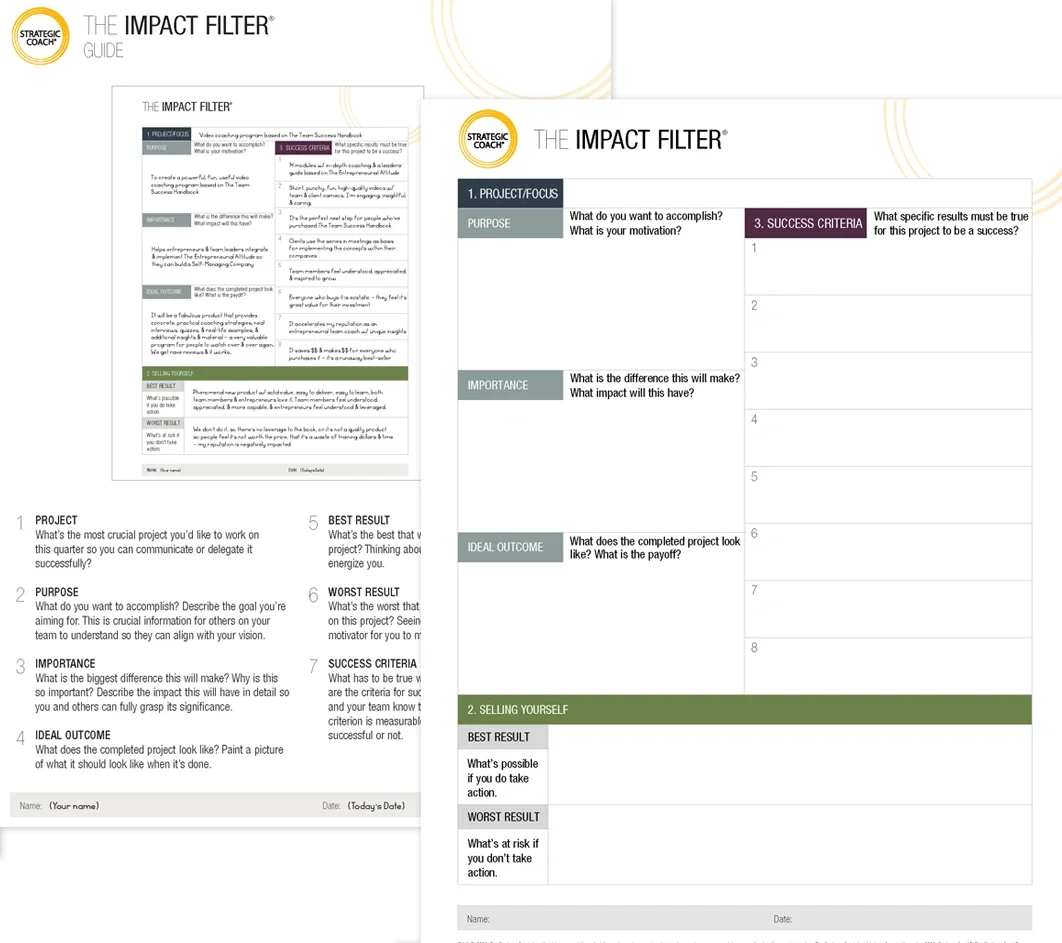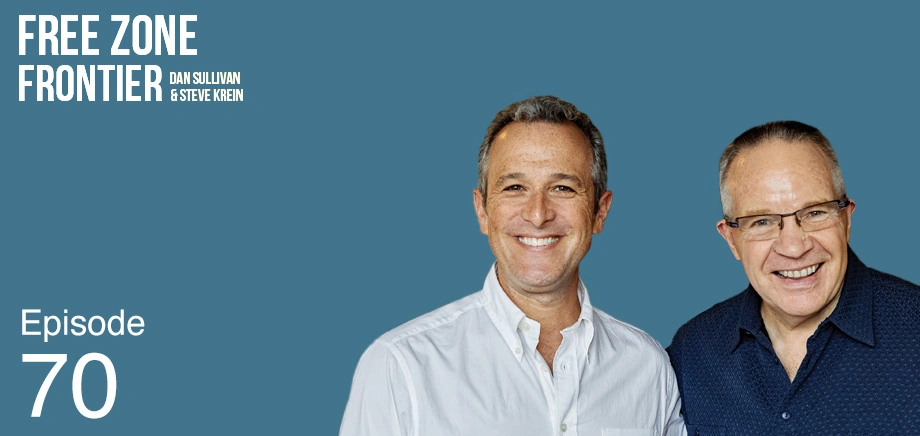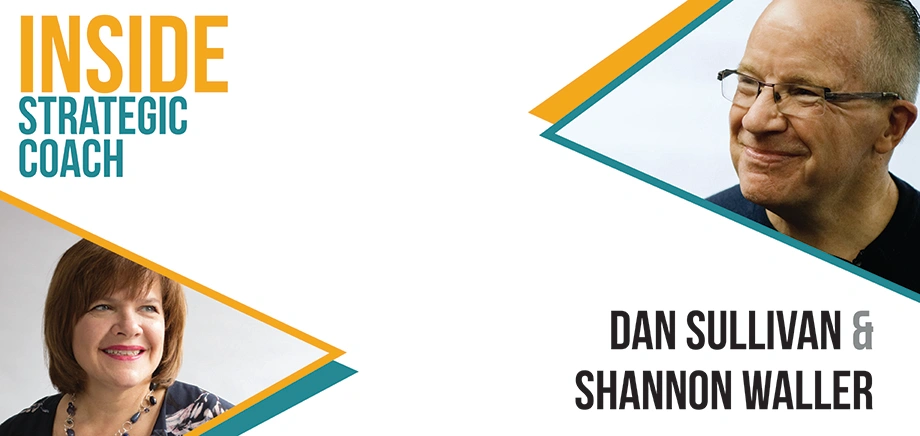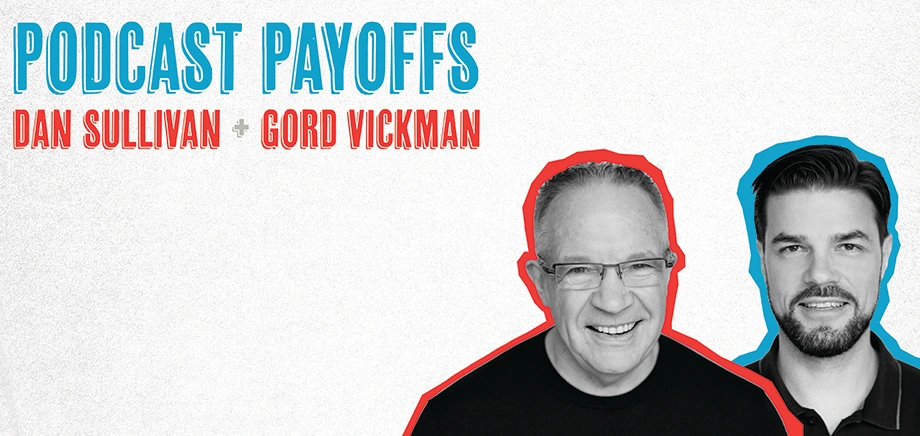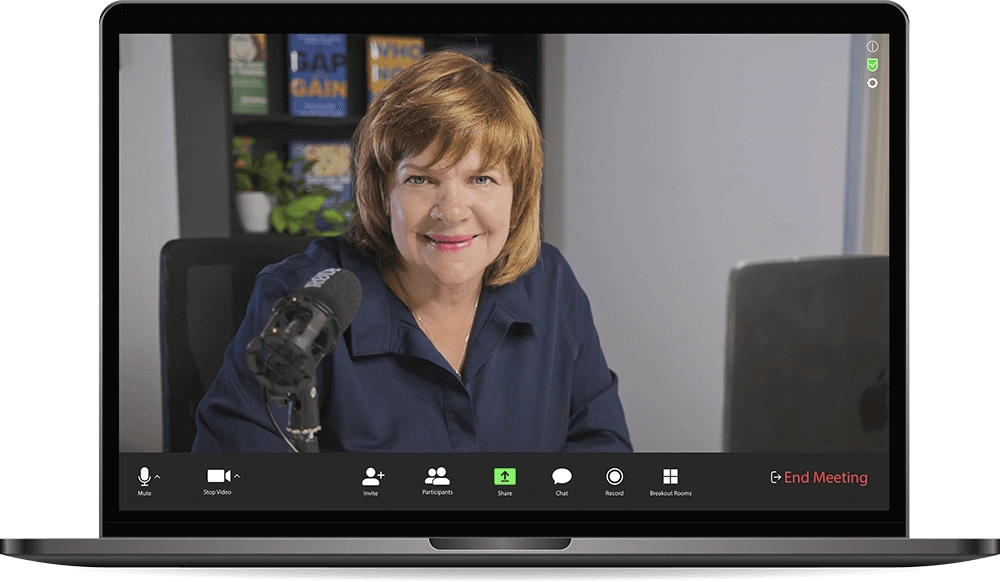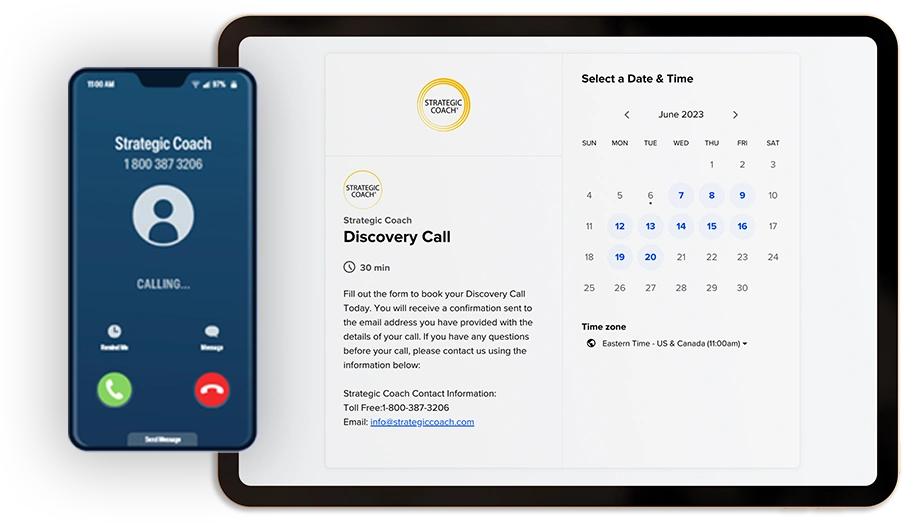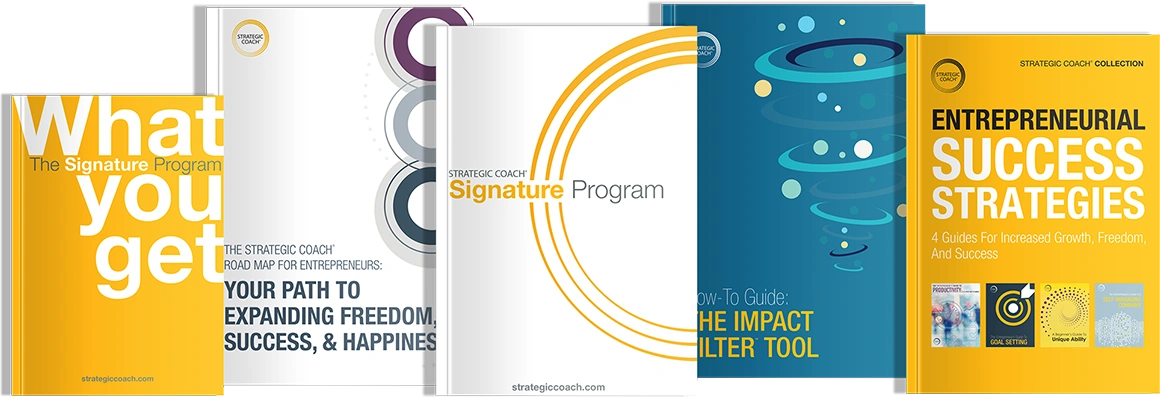Living Forever Starts With Visionary Optimism
June 17, 2025
Hosted By
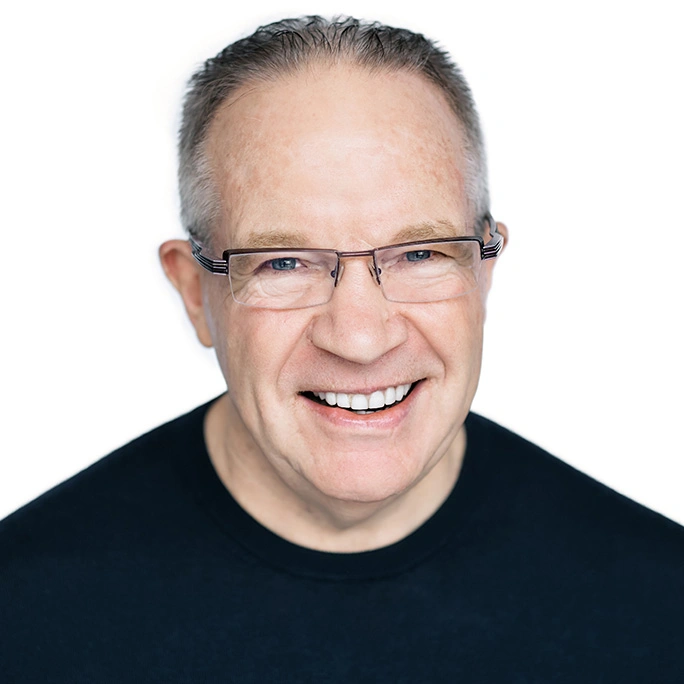 Dan Sullivan
Dan Sullivan
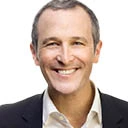 Steve Krein
Steve Krein
Innovations in the realm of age reversal are accelerating. Getting physically younger while getting older in years is a real possibility. In this episode, Dan Sullivan and Steve Krein explain the advances, discuss what’s needed for further breakthroughs, and share why age reversal developments are critical for entrepreneurs to be preparing for.
Show Notes:
- Many entrepreneurs retire out of social or societal expectations.
- Setting a goal that might seem crazy serves as a magnet for what you need and as a repellent for what you don’t.
- You treat your remaining years differently depending on when you think you’re going to die.
- Thinking about your legacy means you’re thinking about being gone.
- There’s the expectation in society that once you turn 65 or 70, you don’t take on anything new.
- The solution won’t be possible if you don’t have the goal.
- Medicine is going to become the fastest growing industry in the United States.
- There are thousands of solutions that need to be worked on to enable true age reversal.
- There's been an incredible drop-off in venture capital funding of all areas except health and medicine.
- American progress in all areas is driven by adventuresome consumers.
- Mission alignment is the single most important predictor of success in long-term health-related entrepreneurial ventures.
Resources:
The Strategic Coach® Signature Program
Learn more about Steven Krein at StartUp Health
My Plan For Living To 156 by Dan Sullivan
Episode Transcript
Steven Krein: Hi, this is Steven Krein. I'm here with my podcast partner and coach Dan Sullivan for the latest episode of the Free Zone Frontier Podcast. Hi, Dan.
Dan Sullivan: Hi, Steve.
Steven Krein: I'm excited for this conversation, Dan, because we're going to talk about age reversal and both of our worlds are intersecting here for a number of reasons, one of which is that we're both really excited about the recent acceleration of innovation by entrepreneurs and innovators in age reversal. And so I thought it would be a terrific topic that touches both the Free Zone community, the StartUp Health community, and actually just our lives overall. But I'd love to ask you the question to begin, which is why are you so interested in the age reversal theme, sector, innovation, and community building up and developing as a real industry now that I think people need to take notice of?
Dan Sullivan: And I'm deeply interested in this because I believe that a lot of entrepreneurs retire out of some social expectations or societal expectations. They retire at 65 and 70. And it's been my observation of our entrepreneurs, they're at the top of their game when they retire. So why wouldn't they just continue the top of their game for another 20 or 25 years. And everybody's bought into that. I would say, generally speaking, in one way or another, in terms of their daily practices and their getting properly tested in that, that it would take a long time to prove that we had extended lifetimes by 25 or 30 years. We're extending careers by easily another 10 years than what the person was planning on before they did the thinking about Lifetime Extender.
Steven Krein: Yeah, well, first of all, Dan, there's so many things to unpack here, not just about The Lifetime Extender exercise, which I was just describing. I did a podcast with Brian Kay, who was the one that introduced us 25 years ago. And I was talking about the impact that doing a Lifetime Extender at 28 years old had on me and how much it shaped my life. But I wanna go back to your original comment about why you're so interested in both age reversal, but I think your topic of living to 156 and how everything that has kind of been attracted to you since being publicly, profoundly sharing outwardly, you wrote a book about it, you've talked about it, you've created a community around it.
And this idea of being bold enough to not be laughed out of the room, but actually the opposite, which is all of a sudden now, it's almost attracted people and solutions and things to you. That's why, you know, I've been enamored by the framework of the moonshots and the moon landing for so long and why so much of StartUp Health's work is organized by moonshot, because simply setting a goal that might sound crazy or seem crazy at the time, like the moon landing did in the early 1960s, how it almost serves as a magnet to attract what you need. It also serves as a great repellent to get rid of what you don't need or people that you don't need.
And so just starting with that 156 proclamation that you made, so you thought about it for three years, you started sharing it. I know you shared it within our community early on, but you've been bolder and more open and more transparent about sharing with everybody and anybody. And I just want to ask you the question of, you know, over the years, what has been the shift in the kind of people that have come around interested in that versus those that have either laughed about it or thought you were absolutely nuts for saying that you want to live to 156?
Dan Sullivan: Yeah, well, you know, I'm choosy about the human settings I get into. So, you know, I'm not out on the street corner talking about this. Generally speaking, my social world is entrepreneurial. Most of the people that we interact with socially are entrepreneurs. I put them through the little Lifetime Extender test, and they're amazed at what happens to their thinking. So as we discussed in previous podcasts, Steve, it's all about mindset, okay? And that if you have a mindset that you're gonna be dying at the actuarial age of 78, and let's say you're in your forties or fifties, you're gonna conduct those next 30 years very, very differently than if you've extended that number from 78 to, let's say, 105. And there's some fundamental mindsets that immediately arise.
And one of them is, I've got a lot of time yet. Okay, planning what's going to happen at 100. And I do that with no negative feedback in my own brain. It's just second nature for me to think in these terms. But I look back to 70, and you'll remember my 70th birthday party at the Four Seasons in Toronto. And I was looking back at what I had achieved since I was 70. And I can honestly say that I think I've created more and produced more since I was 70 than I did before 70. If I take 1 to 70, then I think it's a function that I have this attitude that there's an amazingly big future lying ahead of me. I catch people talking about, well, I'm in the point now where I'm thinking about my legacy. And I said, that sounds like something that gets chiseled on a tombstone.
And I said, legacy? That means you're gone, right? I said, I don't have any thoughts like that. I don't have any thoughts. You know, you starting to wind down now? I said, wind down? No, I'm not winding down. So there's all these common ways in a normal expectation society that when you hit 65 or 70, you don't take on anything new. You don't take anything bigger. You don't commit yourself to any kind of new learning. You're not really forming new relationships, you know, and everything. You're just kind of waiting for the departure. So that's the personal impact. And then I think that the clients, Coach clients, the entrepreneurs in the Program have talked a lot with each other about this. And I think they're reinforcing each other, you know, to stay fit and to watch their health and they're sharing information.
So I think we've created a gathering here around a particular topic, which certainly since 2010, has become incredibly more possible in terms of what's available from science and medicine and technology.
Steven Krein: Yeah. So let's dig into that a little bit because I think the context of the 25-year period is pretty much measured, like you just described, by a lot of people where you're kind of shutting down and you're retiring or you're kind of thinking about legacy. Yet, you and the community, and I think everybody who subscribes to this philosophy, is looking for now solutions, lessons, education, people who want to be a part of that kind of effort. And I think there's a manifestation, if you will, by who you surround yourself with. And then the idea that we're aligned on creating a world where not only we can live longer and healthier, have long health spans, but we can actually live in a moment in time where age reversal is going to be possible.
So let's talk about the last couple of years, as you've almost found yourself in the middle of conversations, at events, in programs, around people who are working on the very solutions as a result of you sharing it openly and outwardly with so many people. Where I think we're going to create that future because we're going to be putting that message out that we're all looking for people, solutions, and breakthroughs that are going to enable age reversal and make 156 possible.
Dan Sullivan: Yeah, and the truth is people say, well, how is that even possible? And I said, well, you know, the thing about this is that it won't be possible if you don't have the goal. So the reason I have the goal is to stack the odds in favor that I'll find out the information, I'll find out the—our eyes only see, our ears only hear what our brain is looking for. But the big thing is that even the people in the medical community who are at the front lines of this are deeply surprised by what's happened over the last 10 years. And there was two big things. One was the Dr. Yamanaka, who I was pleased to meet working at the Gladstone Institute in San Francisco. When the whole notion of stem cells became a topic, they saw it as only one source for the stem cells, and that would be embryos. It would be things related to the human embryo. And there's a lot of ethical and moral issues that immediately come up as obstacles to that.
The babies are being transformed into raw material for medical research. I don't like the idea of that. I think there's a lot of people who don't like that. But what Dr. Yamanaka came up with the idea was that maybe any cell in the body can be turned into another cell. And what they've discovered is that you can take a skin cell and break it down. And the analogy that I've come up, a layman's analogy, it's like I have a plastic, this is a dispenser, it's for cleaning your hands. It's made out of plastic. All the parts of this are made out of plastic, and this all came from oil. This is a product that started with petroleum, and there's about 10,000 different products that you can make out of petroleum. I imagine the desk that I'm at looks like wood, but it may not be wood. It may be something made out of petroleum.
So what Dr. Yamanaka came up with as a solution, it was like he took a differentiated cell, which is skin cell, and took it back to the universal cell, which is undifferentiated, and then found out how you can take that undifferentiated and turn it to another purpose. Okay, so for example, there's a doctor in our program who was the first doctor to come up with a stem cell solution for congenital heart disease with babies who were born with not enough pumping power in their hearts. And sometimes it's just very, very weak heart muscles or it may be even missing muscles. And over a nine-year period, he was able to go deeper and deeper and deeper of taking baby skin cells and actually taking them back to their original state and then turning them into heart muscles.
And he was telling me that the people in the medical community are shocked. The guy looks like clear liquid, you know, it's a sort of milky liquid when you have it that you're going to inject this in the baby's heart. And he put it in a Petri dish in the lab. And all of a sudden, after about five minutes, part of the Petri dish went thump, thump, thump, thump. And then after about 10 minutes, the whole surface was going thump, thump. It was a heart muscle, and it was liquid in a dish, and it had come from skin cells. And he said, depending on your religious orientation or your background, he says, this is a miracle. This is kind of like a miracle.
Right now, it takes about $100,000 of funding to do one baby, sufficient that you can almost say, just based on the health of their heart, they can live a full lifetime, where otherwise 50% of them are dead by five, and very few make it past 25. Anyway, this is amazing, and it wasn't even envisioned 10 years ago. And part of the reason is another breakthrough, which is artificial intelligence. As I understand it, they can take biological signals of cells and they can translate it into electronic cells with that new ability. They can do 10,000 tests electronically, where if they were doing the biological tests manually, they could just do one. This is a very, very significant acceleration of research.
And it's that crunching power of the computers applied to medical research, and then all the new technologies that develop out of that, is what suddenly take in this one field. I think this is the main field. And I think medicine is going to be the fastest growing industry, but not everywhere. I think it's only going to be in the United States.
Steven Krein: Yeah. Yeah. I want to ask you why. And then I want to go into the bigger framework because we use the moonshot example because I think it's a perfect framework for none of the technology existed. A lot of the technology didn't exist, in fact, when JFK proclaimed landing an American on the moon and bringing them safely back. But the idea that for a decade, you'd have a collaboration among 40,0000 people and 20,000 companies working within their own Unique Ability to do all of their Unique Ability in a way that would lead to the success of one thing, which is landing man on moon and bring him safely back. And I think if you talk about age reversal, that's one thing.
Now, there are hundreds, if not thousands of parts of that, that are going to need to be worked on to enable true age reversal. And so we're excited by this generation of entrepreneurs and innovators empowered by what you just described, the technology, the solutions, their own experience. But this idea of a shared vision and mission that we're going to work on truly making sure that age reversal is possible within our lifetime. And I believe much like any big goal, the idea of having it will help open up the avenue for the creation of the solutions that help us get there.
Dan Sullivan: Yeah, I think right now there are coaching programs that go with this. You know, you're not drinking enough water, you're not getting proper sleep. I mean, not revolutionary things, but put them all together and they produce a different physical outcome, a different health outcome. But the big mindset shift, Steve, and I'd like you to talk about this, is that there's a paradigm now that all disease, is simply one aspect of aging or another aspect of aging. And that aging is actually the disease, and it shows up in different people in different places, depending on which part of their body is going through deterioration.
Steven Krein: What I've noticed as we've gotten deep into different diseases, type 1 diabetes, type 2 diabetes, Alzheimer's disease, all kinds of autoimmune diseases, metabolic diseases, the common thread is that I've noticed historically everyone's looked in silos at each one of these separately. Not enough people have been thinking macro about what crosses through all of the different diseases and illnesses and conditions. And I think what is possible now is just cross-disciplinary collaboration. And what we've been trying to do for the last decade at StartUp Health is really break down the silos, not just between diseases and illnesses and conditions, but the perspectives.
So you take a academic perspective, you take a venture capital perspective, you take an entrepreneur perspective, you take an industry perspective, and you identify within those different perspectives, those that are visionary optimists who believe that there's an opportunity to learn from each other and then apply what you're learning to your specific disease or disease area. And I think age reversal, like you said, is almost a horizontal instead of a vertical issue. It doesn't just become like, do you study age reversal? But you have to look at everything you know, separately and together.
And so, again, a macro view of what we're doing at StartUp Health is this idea of a global community of entrepreneurs and innovators trying to solve the biggest health challenges in the world and learn from each other. And I think I'm more focused at StartUp Health at the global community aspect of people being in a collaborative environment to work together, to discover, to share what is working and what's not working, and get out of the siloed kind of world they typically live in, in healthcare in particular, research and development commercialization scale are two different worlds, and there's no reason for them to be. And in fact, the kind of collaborative technologies and the collaborative frameworks of global collaboration, I think, lends itself to that.
Dan Sullivan: Yeah. I'm in disagreement with a number of people about this. I said, I think that the great breakthroughs, with the exception of maybe Cambridge University in the UK and Tel Aviv, that seem to be the two other places where extraordinary research breakthroughs are occurring, is because the U.S. is going to fare better as a country over the next 20 or 30 years, where it will become a magnet for capital. And you can see it already with the strength of the dollar that is already happening. The dollar is the universal currency medium of exchange that people bet on. But the other thing is that the U.S. is geographically and demographically not involved in a lot of the issues that are going to take place on the planet.
So there's two things happening right now widespread, and that's depopulation. My prediction is, and I'm gathering this from smarter people than myself, is that the next billion that will hit will be 7 billion. And there's a good chance we'll hit 6 billion. And this is just from the fact that for most of the developed world over the last 40 years, they haven't been having babies. China is the you know, the most extraordinary example of that. Around the world, all the populations are now moving above 50, they're moving above 60, but they're not in great health. They're not in great health.
And so you're gonna have a billion person loss, that's simply because that's, you know, that people die in their sixties and seventies. And there's the population above 60 is getting above the population under 20. Well, people aren't living longer right now, right? And it's declining. And generally the health, strange as it may seem, because Americans are very self-critical, but generally speaking, with exceptions of this community or that community, global health and fitness really isn't up to North American standards. And if you look at the stretch from Boston to probably North Carolina, and then that's on the east coast of the United States, and then you go from San Francisco down to San Diego, 90% of the breakthrough research on this particular topic is happening in those two stretches. And it's a function of enormous venture capital. It's a function of amazingly top-notch medical facilities.
And then the capital markets that are now looking for new places where there's gonna be breakthroughs that they can get a return on their bets of capital. And I think it's retreating. We're seeing an enormous retreat. I was reading a Wall Street Journal article on the weekend that there's just been an incredible drop-off in venture capital funding of all areas except this one.
Steven Krein: Well, what we found, and I actually think the venture capital market in particular chases trends and transactions.
Dan Sullivan: Well, they bet on bets.
Steven Krein: Yeah, they bet on bets, but typical life cycle of funds are 10 years and the structure doesn't lend itself to real breakthrough because oftentimes it takes longer than 10 years. We've noticed that there's a—and I think your community, my community, Peter Diamandis' community, and all of these different groups, Richard Rossi's community, are visionary optimists with even a hint of informed optimism, but it's not informed pessimism. And I kind of use that optimism, pessimism, informed, and visionary as important distinctions because I think there is a very important moment for entrepreneurs, innovators, venture capitalists, clinicians, researchers, to figure out which side they're on here in relation to age reversal, because I do think it needs to be in that zone of visionary optimism or informed optimism to believe that what we can do over the next 5, 10, 15, 20 years is possible.
For limited partners in venture funds, for a lot of academics, they're more informed pessimists or skeptics, and that doesn't lend itself to what I think is needed right now in this generation. In fact, I think one of the best parts of the discussion we're having right now, but the discussion that's being had around age reversal overall is a sea change in the number of people who are now visionary optimists, informed optimists about what's possible. And I do think that's actually as simple as that mindset question you always ask around, do you have a transformational mindset or conventional, because a lot of conventionally minded people will reject the notion of any of this being possible.
Dan Sullivan: Well, the other thing about it is that American progress in all areas is driven by adventuresome consumers. And the U.S. just has massive amounts of really wealthy adventuresome consumers. I think Warren Buffett sort of summed up what the prevailing mindset is in the entrepreneurial world about this age reversal thing. He was at Columbia University, where he graduated his master's degree in Columbia University a long time ago, and he was talking to grad students. One of them asked him, Mr. Buffett, is there anything in the world that you would give your entire fortune for? And Warren Buffett said, how old are you? And the student says, 21. And Warren Buffett said, I'd give my entire fortune for 21, knowing what I know today.
We're not talking about millions of dollars here, we're talking about billions of dollars. The other thing is the doctor, Tim Nelson, who is a Coach member now, I told him, I think your medical breakthrough is really great, but I think your funding model is incredibly significant. And that is he got a wealthy couple who had the problem in their family, a daughter with congenital heart disease. They met at a conference 10, 12 years ago. The couple came up to him and they said, you know, you're doing the most interesting thinking about this problem. And we just wonder if you're the kind of doctor and scientist who will stick with the project until there's actually a cure. And he said, yes, I am. And they said, well, that's good because we're the kind of donors who will stick with that doctor until there's a cure.
Over a nine-year period, it was $130 million, which they did. And that meant that he was completely free of all the venture capital distractions. And then he just could go deep on this. And now what the couple want to do is to put together an association of billionaires who each will have a particular issue that they'd like to fund one cure. Okay, so he had a name for this was called Reverse Innovation. and I put him in touch with Keegan Caldwell, and I said, you're going to have a lot of IP, you're going to have a lot of patents out of your medical breakthrough, but I want you to get the patent for this thing that you put together.
First of all, I think it's something that a lot of people with a lot of money would be interested in, because in the funding world, especially the charitable foundation world, they don't know what's happening to their money. They give a lot of money, but they don't know what the money does. They don't know what it's related to. I mean, the disease area, they know what that is, but they don't know the specific researchers, they don't know this. Here, it's one-on-one. It's a total commitment on the part of both parties. And I think it's a new model. And the wealth is there, the wealth in the United States.
Steven Krein: It's a big shift. I mean, we've been focused on this for the last decade, which is identifying mission-aligned capital, mission-aligned partners. Mission alignment is the single most important predictor of success in a lot of the long-term health-related entrepreneurial ventures. And if you're trying to make a real impact, I talked earlier, the short-term nature of the venture capital model is like 10 years max. And so people are looking at, hey, is there a transaction to do in the next five to 10 years where we can build something and exit it or IPO it?
And so when you start to talk about what Tim's doing, what hundreds of our companies are doing, which is working on things that are going to take a long time, and if you don't have mission-aligned capital, somewhere not that far down the road, things are going to get real serious real quickly towards Do we want to keep funding it? Do we want to sell it? Do we want to do something that stunts its potential? And I think that might be one of the biggest insights we've gotten over the last decade of supporting close to 500 companies now is this notion of that fork in the road where you have to ask the question about, are we going to double down and go further or are we looking for an exit or a transaction?
And I think the sad part is all too often they're backed by investors who are not mission aligned, they were transaction aligned. If you don't choose to build a board, to build an investor base, to build a team that are mission aligned, you're not going to be able to achieve what it is you're trying to. And for age reversal, the best part about it is getting that mission alignment up front. I think there's now enough interest by people aging into the need. Not that different, by the way, we're seeing this with our type one diabetes moonshot or Alzheimer's moonshot. Build a board, build a funding base, build a network, build an ecosystem of mission aligned people, and you've cleared the pathway to get to where you want to go.
Dan Sullivan: Yeah, and if you think about it, I mean, and I'm simply reflecting the insights of Peter Diamandis, is that the last 75 years have been actually an unnatural world where one country guaranteed global trade. It had never happened before. And already you can see that whereas before COVID, the cost of transportation in relationship to the cost of an end product from anywhere in the world was 1%. I mean, 100 years ago, it was 200%. Now, it was down to 1%. But just in the last three years, it's gone up to about 5%. And you take the cost of transportation by 1%, you just eliminate the profitability of an amazing number of products that can't be part of the global economy.
And his second thing is that the U.S. is going to get picky about where the carrier fleets go, because that's the main vehicle for guaranteeing global trade. More and more, they're taking an interest in the Western Hemisphere, which is the Americas. They're doubling down on Southeast Asia because of a lot of issues there, but they probably won't be in the Mediterranean. And what it means is that globalization is going to go to regional trade groups. It's going to be everybody shifting and doing a deal. But if the cost of transportation, let's say, goes up to about 10% of final cost of product, there's just 95% of the products in the world aren't viable to be sent long range.
But the U.S. is energy independent. They're food independent. They have the greatest internal water system in the world. They have more navigable waterways and ports than any other country. They have the biggest combination of railroads, highways, biggest transportation system. But I think this one area of the age reversal is I'm just putting everything together. And I said, this is going to be the hotspot growth area that everybody's going to want to be interested in. You know, I mean, if any of us in coach, instead of packing it in like 65 to 80, as most entrepreneurs do, we push into our hundreds and the last 20 years are by far our most productive.
Steven Krein: It's the compounding nature, you know, you saw that Warren Buffett's, you know, how much wealth, I think he's like 90 plus percent of his wealth was created after 70, 65 or 70, I think the saying is. And I think metaphorically, I think the compounding nature of everything you're describing is the compounding nature of having it come from the part where you have all of the knowledge, all the wisdom, and that saying where you said he would give all his wealth to be 21 again with all of the knowledge he has now. So if you can do it and live another 20, 30, 40 years after 70 productive, then think about what's possible.
And I think that's where the best breakthroughs are going to come. Your own needs are driving, in a good way, your own needs are driving your alignment. And I think therein lies something often overlooked when people are looking for partners, backers, coaches, investors, board members, is just, do they care? Do they care? And if they do, anything's possible. If they don't, very hard, very difficult.
Dan Sullivan: Yeah.
Steven Krein: Excellent. All right, Dan. Wonderful to pend time, as always. Hi to Babs.
Dan Sullivan: Thank you very much.
Related Content
The Impact Filter®
Dan Sullivan’s #1 Thinking Tool
Are you tired of feeling overwhelmed by your goals? The Impact Filter is a powerful planning tool that can help you find clarity and focus. It’s a thinking process that filters out everything except the impact you want to have, and it’s the same tool that Dan Sullivan uses in every meeting.
